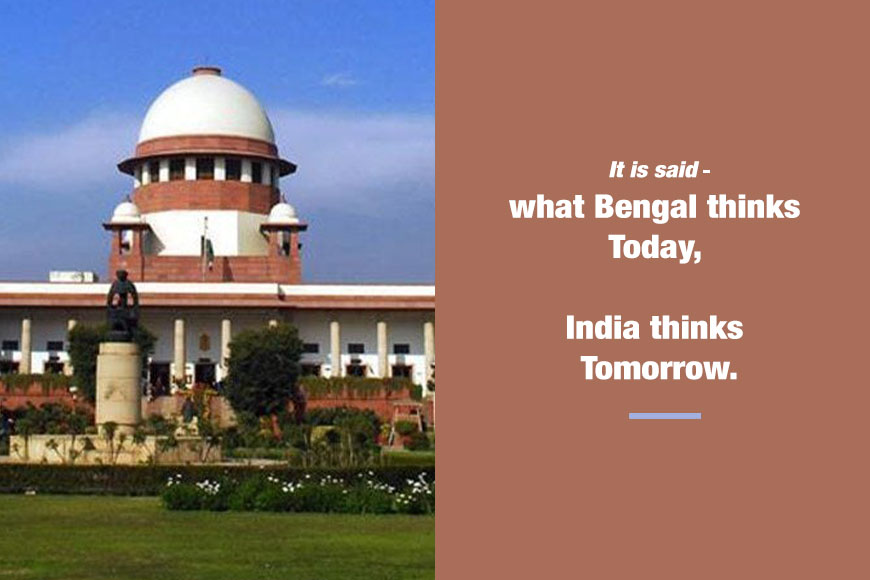Daughters of Bengal always had right on father’s property by Dayabhaga law unlike rest of India!

Pratibha was a Bengali girl married to Avtar, a businessman of Punjab. They were childhood sweethearts. Pratibha was shocked when she realised that her father-in-law had deprived her sister-in-law from any property on his side and gave it all to her husband citing that she was a girl. This was before 2005, when the Hindu Succession Act was not in place. Yet for Pratibha it was a shock, because she never faced this discrimination in Bengal either socially or legally. Because unlike rest of India, property inheritance rights in Bengal stated otherwise. She immediately called up her lawyer father who made it clear that Bengal’s women, be they a widow, a daughter or daughter-in-law had equal rights since time immemorial unlike women in North India. So, the SC ruling that India is lauding today, was something that Bengal followed since centuries.
Interestingly, The Law of Inheritance and Successions in India finds its roots in the Hindu Succession Act of 1956 that was later amended in 2005. As per the old law, when a death occurs without any will then the property is to be distributed as per the guidelines of the law. In India this pattern is not uniform and differed from one region to another as per the customs and guidelines set by the respective religious scriptures and teachings. The region of Bengal (including Orissa and parts of Assam) was the only area under the Dayabhaga system, while rest of India was ruled by Mitakshara system.
As Bhaskar Deb, lawyer Calcutta High Court, says: “Both Dayabhaga and Mitakshara are schools of Medieval Hindu law. Though they are merely different interpretations of the same treatise, but the approach adopted by both schools is radically different. That is primarily because the entire Bengal residency under British rule saw a big impact of education and renaissance even among women, and hence was much advanced in their views. Even the legal system ensured equal rights.”
The difference between how Bengal interpreted inheritance and how other states of India did came from the interpretation of who is a sapinda. Both schools concur on the principle that property should be inherited by the sapindas, but the definition of the word itself given by the schools is different. According to the Mitakshara system it means ‘one that has the same body’ which can be construed as a close relative who is a descendent of a common ancestor. But it’s mentioned such descendance should always be from the male line. And hence only sons could inherit. Sex of a child thus played an important role in the entire cow-belt and even today we find that massive discrimination in the Northern states of India.
“Such a system was not agreeable with Jimutvahana, the founder of the Bengal School of Law. So he brought in the Dayabhaga sytem,” points out Supreme Court lawyer Bijaya Banerjee. “During our Law School days, we learnt how important this word sapinda was to the whole of India and even in a legal framework! And its shocking how such medieval laws kept on ruling India till 2005!”
Banerjee explains sapinda is any relative who can offer ‘pindas’, the balls of rice offered during the funeral of the deceased as per Hindu shastra. This includes women in the family as well, allowing them to freely inherit property. While the Mitakshara system founded by Vijaneswara, following a rigid patriarchal system based on Black Yajurveda quoted ‘Nirindriya hyadayadah strio nritam’ ie. “Women are generally incompetent and do not have the power to inherit.” Jimutvahana did not agree with such reasoning and later Jaimini, the great scholar on Hindu jurisprudence too backed him stating that certain Vedic texts explicitly provide for women owning and possessing wealth.
And thankfully Bengal was always ruled by Dayabhaga Law. Alok Mitra, senior lawyer Calcutta High Court, states, ‘Mitakshara Law propounds a theory of female ownership which is completely different from the Bengal school of Law. Here women do have a title over property but only through their husband or their son, not otherwise. So, there is no direct right to ownership of property or inheritance. And that is extremely medieval and the amendments were made only in 2005 by changing clauses of the existing Hindu Succession Act.’
The Dayabhaga Law of Bengal even protected the interests of widows. Under the Mitakshara system, the widow is entitled to inherit her deceased husband’s property only when he dies leaving behind no male heir and he dies separated from his brothers. Under the Dayabhaga system, the widow’s inheritance is not determined by whether he died separated or united. ‘Thus, by granting the widow the right to inherit her deceased husband’s property when he leaves behind no male issue, the Dayabhaga school dilutes the heavily patriarchal system prevalent in India,’ adds Deb.
Hence the Supreme Court Judgement that states even if a father died prior to 2005, (the year when the Hindu Succession Act was amended and all women across India whether governed by Dayabhaga or Mitakshara got equal inheritance rights), daughters can claim right to the father’s property. When whole of India is lauding this amendment, there is not much ripple among Bengali women, for we always had that right since centuries. That’s how progressive Bengal’s legal system was as was its social structure.









